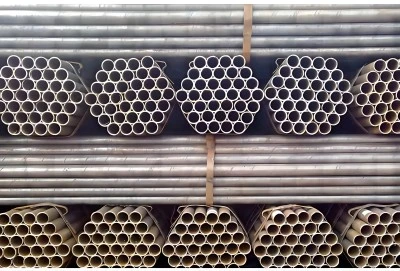ASTM A787 tubing is a crucial component in various industrial applications, known for its specific mechanical properties that make it suitable for a wide range of uses.
|
|
|
Tensile Strength and Yield Strength of ASTM A787 Tubing
The tensile strength and yield strength are two of the most critical mechanical properties of ASTM A787 tubing. These properties determine the material's ability to withstand forces without breaking or deforming permanently, making them essential considerations for engineers and designers.
Tensile strength, also known as ultimate tensile strength (UTS), is the maximum stress that A787 tube can withstand while being stretched or pulled before failing or breaking. For ASTM A787 tubing, the tensile strength requirements vary depending on the specific type and grade of the material. Generally, the tensile strength for A787 tube ranges from 45,000 psi (310 MPa) to 65,000 psi (450 MPa) or higher, depending on the specific grade and heat treatment.
Yield strength, on the other hand, is the stress at which A787 tubing begins to deform plastically. It represents the point at which the material transitions from elastic deformation (where it can return to its original shape) to plastic deformation (where permanent changes occur). The yield strength typically ranges from 25,000 psi (172 MPa) to 50,000 psi (345 MPa) or higher, again depending on the specific grade and heat treatment.
These strength values are crucial for determining the suitability of A787 tubing for various applications. For instance, in high-pressure environments or applications subject to significant mechanical stress, engineers might opt for A787 tube with higher tensile and yield strengths to ensure the material can withstand the operating conditions without failure.
It's important to note that the relationship between tensile strength and yield strength in A787 tube is carefully balanced. A higher tensile strength often correlates with increased brittleness, while a lower yield strength might allow for more ductility and formability. Engineers must consider this trade-off when selecting the appropriate tubing for their specific application.
The manufacturing process also plays a significant role in determining the final strength properties of A787 tubing. Cold-worked tubing, for example, typically exhibits higher strength values compared to annealed tubing of the same composition. This is due to the strain hardening that occurs during the cold-working process, which alters the material's microstructure and enhances its strength.
Elongation and Hardness Requirements for A787 Tubing
Elongation and hardness are two additional mechanical properties that are crucial in characterizing ASTM A787 tubing. These properties provide insight into the material's ductility, formability, and resistance to wear and deformation.
Elongation is a measure of the material's ductility, expressed as the percentage increase in length that a specimen can undergo before fracture. For ASTM A787 tubing, the elongation requirements typically range from 20% to 35% in a 2-inch (50.8 mm) gauge length, depending on the specific grade and heat treatment. Higher elongation values indicate greater ductility, which is beneficial in applications requiring formability or the ability to withstand plastic deformation without fracture.
The importance of elongation in A787 tubing cannot be overstated. In applications where the tubing may be subjected to bending, flaring, or other forming operations, adequate elongation is essential to prevent cracking or failure during these processes. Furthermore, in dynamic loading situations, higher elongation can contribute to improved fatigue resistance by allowing the material to better distribute stress concentrations.
Hardness, on the other hand, is a measure of the material's resistance to localized plastic deformation. For ASTM A787 tubing, hardness is typically measured using the Rockwell B scale (HRB) or the Brinell hardness scale (HB). The specific hardness requirements for A787 tube can vary widely depending on the grade and intended application, but generally fall within the range of 55 to 100 HRB.
The hardness of A787 tube is particularly important in applications where wear resistance is a concern. Higher hardness values typically correlate with improved resistance to abrasion and wear, making harder grades of A787 tube suitable for applications involving particle erosion or frequent contact with abrasive materials.
It's worth noting that there's often an inverse relationship between hardness and ductility in metallic materials. As hardness increases, elongation (and thus ductility) tends to decrease. This trade-off must be carefully considered when selecting A787 tubing for specific applications. For instance, in applications requiring both wear resistance and formability, a balance between hardness and elongation must be struck.
The heat treatment and manufacturing process of A787 tubing significantly influence its elongation and hardness properties. Annealed tubing generally exhibits higher elongation and lower hardness, making it more suitable for forming operations. Conversely, cold-worked or heat-treated tubing may have lower elongation but higher hardness, making it more appropriate for applications requiring wear resistance or higher strength.
Differences Between ASTM A787 Types (Type 1, Type 2, etc.)
ASTM A787 tubing is available in several types, each with its own set of characteristics and intended applications. Understanding the differences between these types is crucial for selecting the most appropriate material for specific use cases. The main types of A787 tubing are Type 1, Type 2, and Type 3, each with distinct properties and manufacturing processes.
Type 1 A787 tubing is cold-drawn and stress-relieved. This type offers high strength and good dimensional accuracy. The cold-drawing process enhances the material's mechanical properties, resulting in higher tensile and yield strengths compared to hot-finished tubing. Type 1 tubing is often used in applications requiring precise dimensions and high strength, such as in hydraulic and pneumatic systems.
Type 2 A787 tube is cold-drawn and annealed. The annealing process after cold-drawing results in a material with improved ductility and formability compared to Type 1. While it may have lower strength values than Type 1, Type 2 tubing is more suitable for applications involving bending, flaring, or other forming operations. It's commonly used in heat exchangers, condensers, and other applications where formability is a priority.
Type 3 A787 tubing is hot-finished. This type is produced by hot rolling or extrusion and is typically used in applications where the higher dimensional tolerances of cold-drawn tubing are not required. Type 3 tubing generally has lower strength values compared to Types 1 and 2 but offers good weldability and is more cost-effective for larger diameter applications.
The choice between these types depends on the specific requirements of the application. For instance, if high strength and precise dimensions are needed, Type 1 would be the most suitable. If formability is a priority, Type 2 would be the better choice. For applications where cost-effectiveness and weldability are more important than tight tolerances, Type 3 might be the most appropriate option.
It's important to note that within each type, there can be further variations based on the specific grade of steel used. These grades can affect the chemical composition, mechanical properties, and corrosion resistance of the tubing. For example, some grades may offer enhanced corrosion resistance for use in more aggressive environments, while others may prioritize high-temperature strength for use in heat exchangers or boilers.
Contact Longma Group
The manufacturing process for each type of A787 tubing also influences its microstructure, which in turn affects its mechanical properties. Cold-drawn tubing (Types 1 and 2) typically has a finer grain structure, contributing to higher strength and improved surface finish. Hot-finished tubing (Type 3), on the other hand, may have a coarser grain structure but can offer advantages in terms of residual stress reduction and improved machinability.
When selecting A787 tubing, it's crucial to consider not only the type but also the specific grade and manufacturing process. Factors such as operating temperature, pressure, corrosive environment, and any forming or welding requirements should all be taken into account to ensure the chosen tubing meets the demands of the intended application.
For high-quality ASTM A787 tubing and expert guidance on selecting the right type for your application, consider reaching out to Longma Group. As one of China's leading ERW/LSAW steel pipe manufacturers since 2003, Longma Group specializes in the production of large-diameter, thick-walled, double-sided, sub-arc-seam welding steel pipes, including LSAW (Longitudinal Submerged Arc Welded) and ERW steel pipes. With an annual output exceeding 1,000,000 tons as of 2023, Longma Group has the expertise and capacity to meet your tube needs. For more information or to discuss your specific requirements, please contact us at info@longma-group.com.














